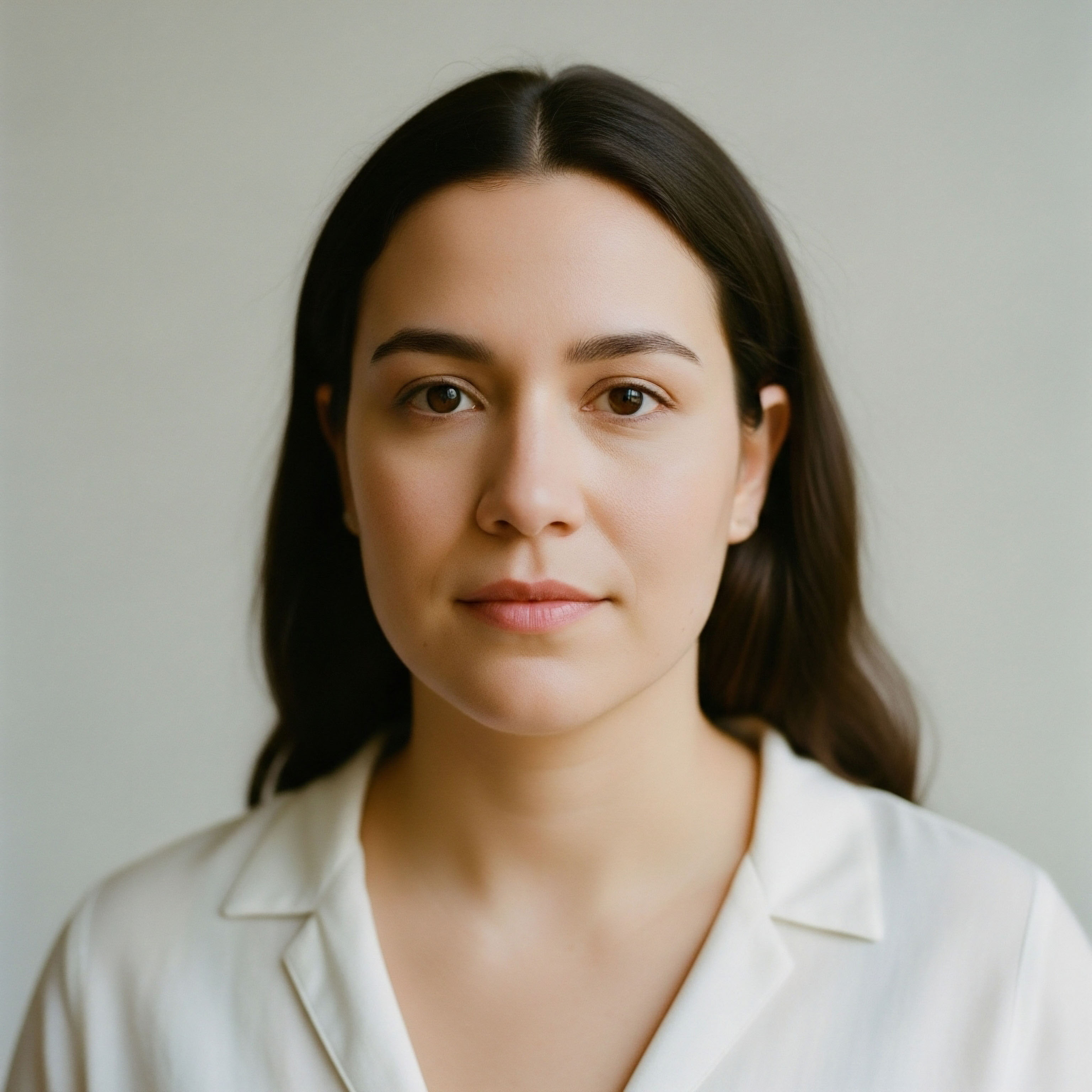

Fundamentals
You feel a vitality, a sense of self that seems disconnected from the reflection in the mirror. This experience is a common and valid starting point for a deeper inquiry into your own biology. The question of whether hormonal optimization can help align how you look with how you feel is a profound one.
The answer begins with understanding that your skin is an active, intelligent organ, functioning as a direct recipient of the body’s intricate hormonal messaging system. It is a visible interface for your internal endocrine health. The firmness, hydration, and overall texture of your skin are governed by the same biological signals that regulate your energy, mood, and metabolic function.
The body’s endocrine system operates as a sophisticated communication network. Hormones are the chemical messengers that travel through this network, delivering instructions to cells and tissues, directing their function. Your skin is densely populated with receptors for these messengers, particularly for estrogen, progesterone, and testosterone.
When these hormonal signals are robust and balanced, skin cells receive the necessary instructions to maintain their structural integrity and youthful function. This includes stimulating the production of collagen for firmness, elastin for flexibility, and hyaluronic acid for deep hydration. The perceived youthfulness of skin is a direct expression of healthy cellular activity orchestrated by these hormones.
The skin acts as a visible map of your internal hormonal landscape, reflecting its balance or decline.
As the body ages, the production of these key hormones naturally declines. This process is a core component of andropause in men and perimenopause and menopause in women. A reduction in hormonal signaling means fewer instructions reach the skin cells. Fibroblasts, the cells responsible for producing collagen, become less active.
Sebum production may decrease, leading to dryness. The entire supportive matrix of the skin begins to weaken. This biological shift manifests visually as thinner skin, fine lines, and a loss of elasticity. Understanding this connection is the first step toward addressing the root cause of these changes. It reframes the conversation from merely treating surface symptoms to restoring foundational systemic balance.

The Primary Hormonal Architects of Skin
To appreciate how hormonal recalibration works, we must first understand the specific roles of the key players. These hormones work in concert to build and maintain the skin’s structure and appearance.

Estrogen’s Role in Skin Vitality
Estrogen is a primary driver of skin health, particularly in women. It directly influences collagen production, maintaining the skin’s thickness and structural support. Estrogen also promotes the synthesis of hyaluronic acid, a molecule that can hold many times its weight in water, which is essential for skin hydration and plumpness.
Its presence supports a healthy skin barrier, protecting against environmental stressors and locking in moisture. The decline in estrogen during menopause is directly correlated with a significant drop in collagen levels, leading to accelerated skin aging.

Progesterone and Testosterone Contributions
Progesterone plays a role in skin elasticity and circulation. Its effects are often synergistic with estrogen. Testosterone, present in both men and women, also contributes significantly to skin health. It influences the thickness of the skin and the function of sebaceous glands, which produce the skin’s natural oils.
In men, higher physiological levels of testosterone contribute to inherently thicker skin. In women, a balanced level of testosterone is important for maintaining skin firmness and a healthy libido, which is itself tied to overall vitality. The optimization of these hormones through carefully managed protocols seeks to restore these vital signals, allowing the skin to function as it did at a younger biological age.


Intermediate
Moving beyond foundational concepts, we arrive at the practical application of hormonal optimization protocols. The objective of these interventions is to re-establish the biochemical signaling that supports youthful cellular function. This process involves a detailed assessment of an individual’s unique hormonal profile, followed by the implementation of a targeted therapeutic strategy.
The therapies are designed to supply the body with bioidentical hormones or to stimulate its own production, thereby restoring the communication pathways that govern tissue health, including the skin.
The core of this approach rests on the Hypothalamic-Pituitary-Gonadal (HPG) axis. This complex feedback loop regulates the production of sex hormones in both men and women. The hypothalamus releases Gonadotropin-Releasing Hormone (GnRH), which signals the pituitary gland to release Luteinizing Hormone (LH) and Follicle-Stimulating Hormone (FSH).
These hormones, in turn, signal the gonads (testes in men, ovaries in women) to produce testosterone and estrogen. Age-related decline in this system leads to the symptoms we associate with andropause and menopause. Therapeutic protocols are designed to support or supplement this axis at different points, depending on the individual’s needs.

Protocols for Female Hormone Optimization
For women in perimenopause or post-menopause, the primary goal is to replenish declining levels of estrogen and progesterone, and in many cases, to optimize testosterone. These protocols are highly personalized, based on symptoms and comprehensive lab work.
A common protocol involves the use of bioidentical estrogen, often administered transdermally (as a patch or cream) to ensure stable delivery and minimize metabolic byproducts. This method directly addresses the loss of estrogen that accelerates skin aging. Progesterone is typically prescribed to balance the effects of estrogen and support its functions. For many women, the addition of low-dose testosterone is a critical component for restoring vitality, libido, and skin tone.
- Testosterone Cypionate ∞ Administered via weekly subcutaneous injections, typically at a dose of 10-20 units (0.1-0.2ml), this protocol provides a steady level of testosterone to support skin firmness, muscle tone, and overall energy.
- Progesterone Therapy ∞ Prescribed based on menopausal status, progesterone can be taken orally or used as a topical cream. It helps to balance estrogen and has its own benefits for skin elasticity.
- Pellet Therapy ∞ This method involves implanting small, long-acting pellets of testosterone (and sometimes estradiol) under the skin. This provides a sustained release of hormones over several months, with Anastrozole occasionally used to manage estrogen conversion if needed.

Protocols for Male Hormone Optimization
In men, the focus is on addressing low testosterone (hypogonadism or andropause). The goal is to restore testosterone to an optimal physiological range, which has systemic benefits for energy, cognitive function, muscle mass, and also skin health. Androgens play a key role in maintaining skin thickness and collagen density.
The standard protocol for Testosterone Replacement Therapy (TRT) is designed to mimic the body’s natural hormonal environment as closely as possible, while maintaining testicular function.
| Medication | Purpose and Administration |
|---|---|
| Testosterone Cypionate | The primary androgen replacement, typically administered as a weekly intramuscular injection (e.g. 200mg/ml). It restores foundational testosterone levels. |
| Gonadorelin | A peptide that mimics GnRH, administered as a subcutaneous injection twice a week. It stimulates the pituitary to produce LH and FSH, preserving natural testicular function and fertility. |
| Anastrozole | An aromatase inhibitor taken as an oral tablet twice a week. It blocks the conversion of testosterone to estrogen, preventing potential side effects like water retention and gynecomastia. |
| Enclomiphene | May be included to directly support LH and FSH production from the pituitary, further supporting the body’s own endocrine signaling. |

The Role of Growth Hormone Peptides
A parallel and often synergistic approach involves the use of growth hormone peptide therapy. These are not hormones themselves. They are secretagogues, which are molecules that signal the pituitary gland to release its own Growth Hormone (GH). As we age, GH production declines, impacting cellular repair and regeneration. Peptides can help restore more youthful GH release patterns.
Peptide therapies signal the body to reactivate its own powerful, endogenous repair and regeneration systems.
Increased GH leads to higher levels of Insulin-Like Growth Factor 1 (IGF-1), a primary mediator of GH’s effects. IGF-1 has potent anabolic and restorative effects on nearly every tissue in the body, including the skin. It promotes cellular proliferation and collagen synthesis, leading to improved skin thickness, elasticity, and wound healing.
| Peptide Protocol | Primary Mechanism and Benefit |
|---|---|
| Ipamorelin / CJC-1295 | This combination provides a strong, clean pulse of GH release from the pituitary. Ipamorelin mimics ghrelin to stimulate release, while CJC-1295 extends the life of Growth Hormone Releasing Hormone (GHRH). The synergy leads to significant increases in IGF-1, supporting fat loss, muscle gain, and skin rejuvenation. |
| Sermorelin | One of the earliest GHRH analogues, Sermorelin provides a more natural, rhythmic pulse of GH release. It is excellent for improving sleep quality and initiating cellular repair. |
| Tesamorelin | A potent GHRH analogue specifically studied for its ability to reduce visceral adipose tissue. Its systemic effects on GH and IGF-1 also contribute to improved tissue quality. |
These protocols, whether for sex hormone optimization or peptide therapy, are grounded in the principle of restoring the body’s innate signaling. By addressing the root cause of hormonal decline, these interventions can produce visible changes in skin quality that are a direct reflection of improved systemic health.


Academic
A detailed examination of hormonal influence on skin aesthetics requires a descent into the molecular and cellular biology of dermal tissue. The visible characteristics of aging skin are macroscopic manifestations of microscopic events, governed by the binding of hormones to specific cellular receptors and the subsequent activation of genetic transcription pathways. The efficacy of hormonal optimization protocols is predicated on their ability to directly intervene in these fundamental biological processes.
The skin’s response to sex hormones is mediated by nuclear hormone receptors located within keratinocytes, fibroblasts, melanocytes, and sebaceous glands. Estrogen exerts its effects primarily through two receptor subtypes, Estrogen Receptor Alpha (ERα) and Estrogen Receptor Beta (ERβ). ERβ is the predominant subtype found in the skin.
When 17β-estradiol binds to these receptors, the receptor-ligand complex translocates to the cell nucleus. There, it binds to specific DNA sequences known as Estrogen Response Elements (EREs). This binding event initiates the transcription of target genes, including those responsible for producing type I and type III collagen and hyaluronic acid. This is the direct mechanism by which estrogen maintains the skin’s structural matrix.

Quantitative Impact of Hormonal Therapy on Skin Metrics
Clinical research provides quantifiable evidence of these mechanisms. A systematic review and meta-analysis of 15 controlled trials, encompassing 1,589 menopausal women, demonstrated statistically significant improvements in key skin parameters with menopausal hormone therapy (MHT). The analysis revealed a standard mean difference of 2.01 for collagen content, indicating a substantial increase in the MHT groups compared to placebo.
Skin thickness also showed a significant increase, with a standard mean difference of 1.27. These findings are consistent with earlier studies, such as a double-blind, placebo-controlled trial that reported a 30% increase in dermal thickness after 12 months of oral estrogen therapy.
The effects on skin elasticity, while statistically significant, were more modest, with a standard mean difference of 0.28. This suggests that while hormonal therapy can robustly restore the skin’s supportive collagen framework, the restoration of elastic fiber function may be a more complex process. Some studies suggest that the timing of intervention is a critical variable; initiating therapy earlier in the menopausal transition may yield more comprehensive benefits for skin elasticity.

What Are the Specific Effects on Collagen Synthesis?
The influence of estrogen on collagen is not limited to quantity. Research indicates that estrogen also affects the quality and ratio of collagen types. It has been shown to increase the ratio of type III collagen, the “youthful” collagen that is more abundant in young skin, relative to type I collagen.
Furthermore, estrogen appears to decrease the activity of matrix metalloproteinases (MMPs), enzymes that are responsible for degrading collagen and elastin. This dual action of stimulating new collagen synthesis while simultaneously inhibiting its breakdown is a powerful anti-aging mechanism at the cellular level.
The following list outlines the established molecular actions of estrogen in the skin:
- Stimulation of Fibroblasts ∞ Binds to ERβ on dermal fibroblasts, directly upregulating the genes for COL1A1, COL1A2 (Type I collagen), and COL3A1 (Type III collagen).
- Inhibition of MMPs ∞ Downregulates the expression of MMP-1 (collagenase) and MMP-3 (stromelysin), preserving the existing extracellular matrix from degradation.
- Increased Hyaluronic Acid ∞ Upregulates the Hyaluronan Synthase 2 (HAS2) enzyme in keratinocytes, leading to increased production of hyaluronic acid and improved epidermal hydration.
- Improved Barrier Function ∞ Enhances the production of lipids in the stratum corneum, strengthening the skin’s protective barrier and reducing transepidermal water loss.

Androgens and Growth Factors a Systems Perspective
While estrogen is a dominant factor, a purely estrogen-centric view is incomplete. Androgens, acting through androgen receptors in the skin, are known to increase sebum production and contribute to dermal thickness. The decline of DHEA, a precursor to both androgens and estrogens, contributes to the overall thinning and drying of aging skin. TRT in men and the use of low-dose testosterone in women can therefore address aspects of skin aging that estrogen alone cannot.
Furthermore, the endocrine system for skin health extends to the Growth Hormone/IGF-1 axis. Peptides like Ipamorelin and CJC-1295, by stimulating endogenous GH secretion, lead to a surge in hepatic IGF-1 production. IGF-1 has its own receptors in the skin and acts as a potent mitogen, promoting the proliferation of both keratinocytes and fibroblasts.
This creates a powerful synergistic effect when combined with sex hormone optimization. The sex hormones provide the primary instructions for matrix protein synthesis, while IGF-1 provides a powerful proliferative signal that enhances the overall regenerative capacity of the tissue. This integrated, systems-biology approach offers the most comprehensive strategy for addressing the multifactorial nature of cutaneous aging.

References
- Pivazyan, L. et al. “Skin Rejuvenation in Women using Menopausal Hormone Therapy ∞ A Systematic Review and Meta-Analysis.” Journal of Clinical Medicine, vol. 12, no. 24, 2023, p. 7598.
- Lephart, E. D. & Naftolin, F. “Menopause and the Skin ∞ Old Favorites and New Innovations in Cosmeceuticals for Estrogen-Deficient Skin.” Dermatology and Therapy, vol. 11, no. 1, 2021, pp. 53-69.
- Stevenson, J. C. & Thornton, J. “Effect of estrogens on skin aging and the potential role of SERMs.” Clinical Interventions in Aging, vol. 2, no. 3, 2007, pp. 283-297.
- Pollacco, J. et al. “Menopause and the effects of Hormone Replacement Therapy on skin aging ∞ A Short Review.” Gynecological and Reproductive Endocrinology & Metabolism, vol. 2, no. 4, 2021, pp. 1-6.
- Rzepecki, A. K. et al. “Estrogen-deficient skin ∞ The role of topical therapy.” International Journal of Women’s Dermatology, vol. 5, no. 2, 2019, pp. 85-90.

Reflection

What Does Vitality Mean to You?
You began this inquiry with a feeling, a sense that your external appearance was not keeping pace with your internal state of being. The information presented here provides a biological basis for that feeling, connecting the visible signs of aging to the subtle, systemic decline in hormonal signaling. The data and protocols offer a map of the underlying mechanisms. This knowledge is the foundational step.
The path forward involves a personal exploration. How do these systems function within your own unique biology? The data in your bloodwork, combined with the story your symptoms tell, creates a complete picture. This journey is about understanding your own body with a new level of clarity.
It is an opportunity to move from a passive experience of aging to a proactive engagement with your own health and longevity. The ultimate goal is congruence, where the vitality you feel on the inside is fully and accurately reflected in your physiology, from the cellular level to the person you see in the mirror.



